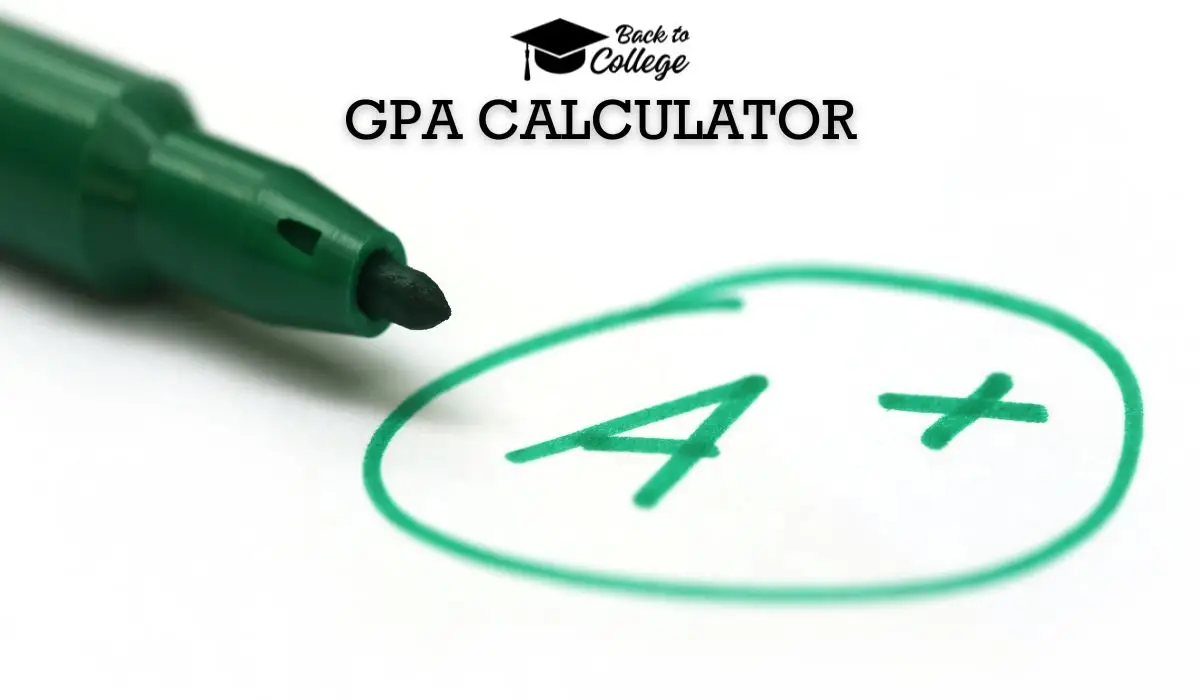Welcome to Back2College’s GPA Calculator. If you want an easy way to keep track of your grades, this tool is here for you. Just enter your grades and credits, and it will calculate your GPA for you. It’s a straightforward way to see how you’re doing and plan your next steps. Give it a go and see where you stand!

GPA Calculator
| Course | Credits | Grade/Percentage |
|---|---|---|
Understanding GPA Calculators
A GPA calculator is a tool that helps you calculate your grade point average (GPA).
GPA is a numerical representation of a student’s overall academic performance. It is calculated by averaging the grades earned in all courses taken, with each course grade weighted by the number of credits earned for that course.
GPA formula: (sum of grade points × total credits) / total credits
This calculator is typically used by students to track their academic progress and to determine their eligibility for scholarships and other academic opportunities. Grading in education is a crucial tool for evaluating student performance and making decisions about admissions, placement, and graduation.
You can use the Raise GPA Calculator to estimate and plan your studies to achieve your desired GPA.
Unweighted GPA
The unweighted GPA calculation method assigns equal weight to each course grade regardless of the course’s perceived difficulty.
This method is often used for simplicity and consistency, but it does not capture the nuances of course difficulty.
While it is a valuable metric for assessing academic performance, it is important to consider other factors, such as course selection, extracurricular activities, and standardized test scores, for a more comprehensive educational assessment and evaluation. This method is reported on a scale of 4.0.
Weighted GPA
A weighted average method is used to calculate GPAs, which takes into account the difficulty of the courses. Each course grade is assigned a numerical value and then multiplied by the corresponding course credits.
The weighted values are then summed and divided by the total course credits to get the overall GPA. This method is reported on a 5.0 scale.
Rounding and GPA Representation
GPAs are typically expressed as decimal numbers, with two or three decimal places being the most common formats. For instance, a GPA of 3.75 indicates an average grade between A and A-. Rounding is often applied to the final GPA calculation, ensuring a consistent representation of academic performance.
Letter Grades and GPA Equivalents
Academic grading in the United States typically assigns the following numerical values to letter grades:
| Letter Grade | Grade Point Scale | Percentile |
| A+ | 4.0 | 97-100 |
| A | 3.9 | 93-96 |
| A – | 3.7 | 90-92 |
| B + | 3.3 | 87-89 |
| B | 3.0 | 83-86 |
| C + | 2.7 | 80-82 |
| C | 2.3 | 77-79 |
| C | 2.0 | 73-76 |
| C – | 1.7 | 70-72 |
| D + | 1.3 | 67-69 |
| D | 1.0 | 63-66 |
| D – | 0.7 | 60-62 |
| F | 0.0 | less than 60 |
These numerical values are used in the GPA calculation process.
Note: This is the most common grading system, but this is not universal. There are other universities that use a scale that goes up to 5.0
Why should Students track their GPA?
College students need to know and track their GPA for a number of reasons. Here are some of the most important reasons:
- To measure academic progress: GPA is a quick and easy way to gauge how well a student is doing overall and compare their performance to other students.
- To meet academic standing requirements: Most colleges require students to maintain a minimum GPA to stay in good academic standing and avoid probation or expulsion. This typically ranges from 2.0 to 3.0.
- To qualify for scholarships and financial aid: Scholarships and financial aid packages are often based on GPA, and students with higher GPAs are more likely to qualify for these forms of financial assistance.
- To gain admission to graduate school or professional programs: For students pursuing graduate studies or professional programs, GPA is a crucial factor in the admissions process. A strong GPA showcases academic ability and readiness for advanced coursework.
- To make informed decisions about internships and job opportunities: Employers view GPA as a measure of work ethic, dedication, and ability to tackle challenging tasks. A strong GPA can lead to internship and job opportunities that may not be accessible to students with lower GPAs.
Tracking GPA helps students develop essential life skills like goal setting, accountability, and self-awareness. It empowers them to take charge of their academic journey and make decisions that will impact their higher education and future success.
FAQs
What is CGPA?
CGPA, or Cumulative Grade Point Average, is a measure of a student’s academic performance over their entire undergraduate or graduate studies. It is calculated by averaging the grade points for all courses taken.
The cumulative GPA is the average of all the grades on the transcript.
CGPA is important for academic decisions, scholarship awards, and graduate school admissions.
Employers also consider it when evaluating job candidates.
How do you calculate GPA to CGPA?
CGPA formula: (sum of GPAs × total credits) / total credits
To calculate CGPA, you’ll need your GPA for each semester and the number of credits earned in that semester.
Multiply each GPA by the corresponding credits to get the total grade points for each semester.
Then, add up all the total grade points and divide by the total number of credits earned across all semesters. This will give you your CGPA.
To make this process even easier, you can use the Back2College CGPA calculator. All you have to do is insert the required information and press calculate! And you will get your CGPA.
How do you calculate GPA percentile?
You can calculate your GPA percentile by multiplying your GPA by 100 and then dividing the result by the highest possible GPA at your institution. For example, if your GPA is 3.5 and the highest possible GPA at your institution is 4.0, then your GPA percentile is 87.5%.
















